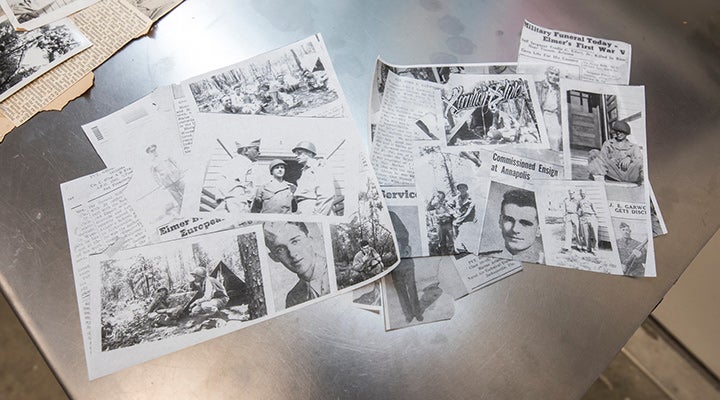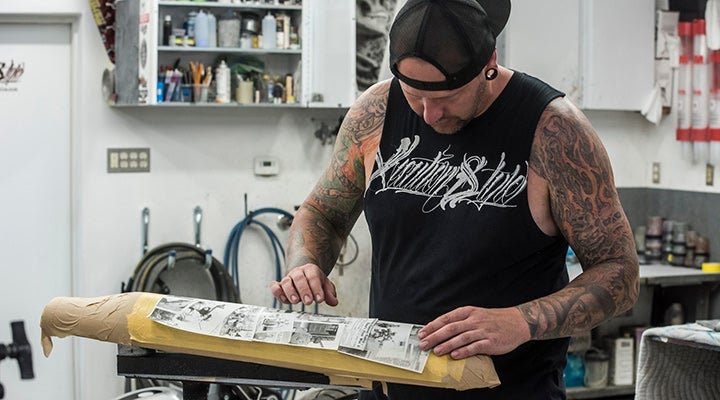Incorporating a montage of authentic newspaper clippings and photographs from the 1940s, Kyle's imaginative fiberglass "bombshell" transforms this symbol of World War II into a stunning tribute to the men and women who serve our country in the armed forces.
Découpage Technique – Kyle Morley
Here’s how Kyle created the dècoupage, along with candy dyes from PPG's Vibrance Collection® line and other PPG products, for this commemorative tribute.
Here's how Kyle created the dècoupage
Step 1 - Assemble Graphics
Old images and articles are put together into a collage. Then black-and-white copies are printed, using old typewriter paper that's half as thick as regular paper. The three pages from the printer are then cut to fit together like a puzzle piece.

Step 2 - Mask for Panels
After the fiberglass "bombshell" is coated with DMD1690 coarse aluminum toner, followed by VM4501 silver flake blended with DBC500 and allowed to dry, an outer panel is marked off using 1-1⁄2" tape. Four diagonal panels are created using ¾" tape. The masking provides a guide to run green ProBand Fineline tape along the inside edges. Each end of the shell is masked off as well.
Step 3 - Check Alignment
Check the graphics for alignment, fitting the puzzle-cut pieces together.

Step 4 - First Graphic
Line up the top graphic over the first panel, then cut it out using the ¾" masking tape as a general guide.
Step 5 - Apply Adhesive
Spray adhesive on the back of the graphic, careful not to any get smudge marks on the graphic itself.
Step 6 - Fasten & Trim
Apply the graphic over the first panel. Squeegee out any air bubbles that may be trapped. Then use an X-Acto knife to trim the graphic exactly along the inside edges of the green vinyl tape.
Step 7 - Finish Graphics
Follow the same procedures to cut, glue and trim the remainder of the artwork. Then apply a heat gun over the graphics to set the adhesive.
Step 8 - Create Drop Shadow
Lightly airbrush a drop shadow along the inside edges of the panels. Use DMX219 black candy dye mixed with DBC500 as a carrier. Allow most of the spray to hit the tape - the overspray creates the drop shadow along the edges. The drop shadow will create a threedimensional effect once the surrounding candy colors are applied.

Step 9 - Apply Clear
After drop shadows are applied, lay new tape over existing tape and apply two light tack coats of DC4000 clear to protect the images.
Step 10 - Adding Color and Effects
For this WWII-commemorative project, Morley applied a low tack, transfer paper to cover and protect the dècoupage. Then he mixed DBC500 with DMX212 red candy dye to create the striping and the overall candy color. Different tape widths were used for the striping and were unmasked in stages as additional coats of the candy color were applied. Additional black candy drop shadows enhanced the overall look. DC4000 clearcoat finished the work.
Step 11 - Unmask
Unmasking reveals the finished dècoupage artwork. Notice how the drop shadow adds depth and dimension to the overall look.

